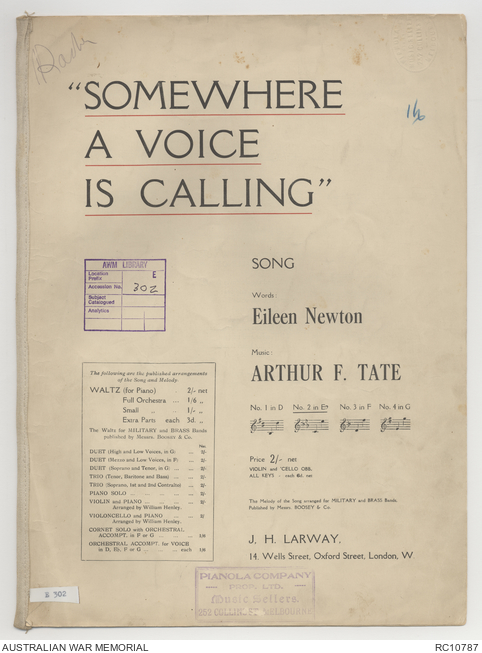| Accession Number | RC10787 |
|---|---|
| Collection number | Sheet Music Collection 302 |
| Collection type | Published Collection |
| Record type | Item |
| Item count | 1 |
| Measurement | Overall: 26 x 36 cm |
| Object type | Sheet Music |
| Maker |
Arthur Frank Tate Newton, Eileen |
| Place made | United Kingdom, United Kingdom: England, Greater London, London |
| Date made | 1911 |
| Conflict |
First World War, 1914-1918 |
| Copying Provisions | Copyright restrictions apply. Only personal, non-commercial, research and study use permitted. Permission of copyright holder required for any commercial use and/or reproduction. |
[Sheet music] Somewhere a Voice is Calling








Sheet music for the song titled, 'Somewhere a voice is calling' with music composed by the British composer Arthur F. Tate and lyrics written by the British poet Eileen Newton. This copy of the music has been published in the key of E flat by J H Larway, of Oxford Street, London. The last two pages of this copy feature lists of new titles by Herbert Oliver and bass/baritone titles available from the publisher, Larway.
The lyrics describe a twilight scene when thoughts have turned to dreams of loved ones, calling from far away. In 1917, Tate wrote an article about the art of song writing with reference to why 'Somewhere a voice is calling', was such a popular song. He commented that the song was written 'by chance', while he was on holiday in Whitby, England. The music took less than an hour to write down and the words were later added by Eileen Newton.
Eileen Newton was a British poet who lived during the First World War and wrote about her experiences. Two of her most well-known poems are 'Last Leave' and 'Revision (For November 11th)', both about the First World War.
Towards the bottom of this page is a sound recording of this sheet music, or a parody, that was created as part of the Music and the First World War project. More information about this recording, including names of the performers, can be found on the catalogue record for the sound recording. A link to the catalogue record for the sound recording can be found at the bottom of this page, under the heading ‘Related objects’ where it can be identified with the prefix [sound recording].
- Download PDF document of [Sheet music] Somewhere a Voice is Calling (file)
-
Listen to
[Sheet music] Somewhere a Voice is Calling
Related information
Subjects
People
Related Objects
- [Concert program] Item 16: Program
- [Concert program] Item 17: Souvenir of No.2. Australian Hospital Ship Kanowna
- [Concert program] Item 20: Programme Royal Alfred Aged Merchant Seamen's Institution
- [Concert program] Item 27: A grand concert
- [Concert program] Item 2: No 2 RFC Cadet Wing programme of concert
- [Concert program] Item 1: Red Cross concert for Australia's wounded
- [Concert program] Item 4: 1st Field Coy Australian Engineers concert
- [Sound recording] Somewhere a voice is calling
- AWM25 93/1 - [Written records, 1914-18 War:] Correspondence regarding "Bands" - Musical Instruments and the formation of Bands in various Battalions
- [Postcard] Somewhere a Voice is Calling (1)